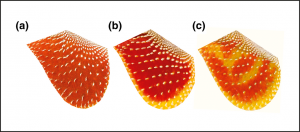At one point or another, we have all seen animals with flaps of skin hanging below their chins— some of us even have them. In lizards it’s called a dewlap, a signaling device thought to be used in mating and defense. Dewlaps come in all shapes, sizes, and colors, and are often expanded and contracted during the male lizard’s display behavior. The function of this fantastic throat fan is a puzzle currently being unraveled by many scientists.

A male anole expanding his dewlap. (Source: Wikimedia Commons)
These lizards, members of the genus Anolis, are native to the Americas and live in a variety of terrestrial environments. It is a diverse genus, making it perfect for studying evolutionary biology. Visible differences exist between sex— the male dewlap is larger and more colorful than the female dewlap— as well as between populations of the same species of anole. Few studies have examined genetic variation of dewlap expression in both sexes, and none have explored how climate is linked to anole diversity. One study by Tess Driessens and a team of researchers does just that. She hypothesized that climate would indeed affect male anole dewlap diversity, and perhaps female as well.
For this study, Driessens and colleagues categorized the dewlap pattern of 17 different populations of both sexes of Anolis sagrei as either solid, marginal, or spotted (below). Other measurements included dewlap size, color, and display, quantified as number of extensions per minute. The authors found that populations in dry environments had a higher proportion of solid dewlaps and reflected more UV light, and this was true in both males and females. Populations in moderately moist environments had a higher proportion of marginal dewlaps and reflected more red. Additionally, males in moister environments used their dewlaps in display more. These findings support Driessens hypothesis; however, no other variables had significant results.

(a) Solid dewlap, (b) Marginal dewlap, (c) Spotted dewlap. (Source: Driessens et.al., 2017)
If the point of a dewlap is indeed for mating and defense, then making the anole more visible should increase the ability of the signal to reach across to a potential mate or predator. Driessens explains that due to the light conditions in dry environments, which tend to be more open, reflecting UV light makes an animal more detectable. In wetter environments such as forest shade, which reflect a lot of green light, reflecting red light is more beneficial if you want to be seen. The researchers also propose that the dewlap pattern may be related to either the available prey species for anoles, or due to predation pressures on anoles. These results warrant further study, as causation is much harder to prove than correlation. Finally, Driessens explains that the increase in display frequency and speed in wetter and shadier environments is simply the male anole’s method of ensuring his signal is getting across.
These results not only add to our knowledge about why dewlaps do what they do, but also have many implications for understanding the effects of climate change on this particular signaling mechanism. Dreissens research so far has no answers as to whether these climate-diversity relationships are a result of long-term evolution, or whether they represent the animal’s ability to adjust quickly– termed “plasticity.” If the former is true, and these anole have little ability to adapt in the short term, then the impact of the current climate trajectory on anole diversity would also be an interesting topic for further study.
(Source: Phooj Vaj. No copyright intended.)
References:
Driessens, T., Baeckens, S., Balzarolo, M., Vanhooydonck, B., Huyghe, K. and Van Damme, R. (2017), Climate-related environmental variation in a visual signalling device: the male and female dewlap in Anolis sagrei lizards. J. Evol. Biol.. doi:10.1111/jeb.13144
